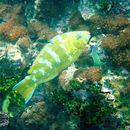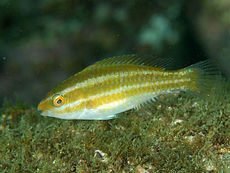tr
kırıntılardaki isimler


Die Bloubalk-papegaaivis (Scarus ghobban) is 'n vis wat voorkom in die Indiese-Pasifiese area, die Rooisee en aan die ooskus van Afrika vanaf Oman tot by Durban. Onvolwasse vissies is al by Algoabaai opgemerk. In Engels staan die vis bekend as die Bluebarred parrotfish.
Die Bloubalk-papegaaivis (Scarus ghobban) is 'n vis wat voorkom in die Indiese-Pasifiese area, die Rooisee en aan die ooskus van Afrika vanaf Oman tot by Durban. Onvolwasse vissies is al by Algoabaai opgemerk. In Engels staan die vis bekend as die Bluebarred parrotfish.
Scarus ghobban és una espècie de peix de la família dels escàrids i de l'ordre dels perciformes.
Els mascles poden assolir els 90 cm de longitud total.[3]
Es troba des del Mar Roig i Sud-àfrica fins al sud del Japó, Nova Gal·les del Sud (Austràlia) i les Seychelles; des del Golf de Califòrnia fins a l'Equador; i, també, al Mediterrani oriental.[3]
Scarus ghobban, also known as the blue-barred parrotfish, blue trim parrotfish, cream parrotfish, globe-headed parrotfish, green blotched parrotfish, yellow scale parrotfish, and bluechin parrotfish,[1] is a species of marine ray-finned fish in the family Scaridae.
This species is blue-green to green in colour and commonly grows to approximately 46 cm. Its appearance is variable. It may have a central stripe on the dorsal and anal fins that is pink in color. The underside of the body may be pinkish or yellowish. There may be blue markings around the area of the pectoral fin.[4]
Scarus ghobban is widespread throughout the Indo-Pacific, known from East Africa to Indonesia. It also occurs in the Galápagos Islands[4] as well as Japan, south to Australia and east to French Polynesia.[2] Recently recorded in 2001 for the first time in the Mediterranean Sea off Israel, following an entry via the Suez Canal, it is now expanding northward in Levantine waters where it remains rare.[5][6]
Like other reef fish with a pelagic larval phase, regional currents facilitate high levels of gene flow, which in turn create high genetic diversity among the species. [7]
Scarus Ghobban occurs in places with sandy bottoms and in areas with seagrass. It is also known to live in marginal reefs and in deeper waters.[1]
Scarus ghobban grows quickly and can live up to 13 years. It tends to congregate in small schools.[1] Scarus ghobban can rotate their mandible bone at a high velocity; this allows them to function as a scraper and facilitate hydrological transport of fine sediments.[8]
Reproduction The way the scarus ghobban reproduces is by the female laying eggs into the current of the water. After about 25 hours after the egg has been fertilized, it'll hatch. After birth, the parrotfish will mature quickly and won't have to be near its parents for much time. [9]
While the species is captured in large numbers by fishermen for consumption and sale, and there is also a high amount of bycatch from other fisheries, it is not particularly targeted and appears not to be threatened at this point. As other parrotfish, it is dependent on coral reefs to some degree, and is likely to suffer from the continued degradation of same.[1]
Scarus ghobban, also known as the blue-barred parrotfish, blue trim parrotfish, cream parrotfish, globe-headed parrotfish, green blotched parrotfish, yellow scale parrotfish, and bluechin parrotfish, is a species of marine ray-finned fish in the family Scaridae.
Scarus ghobban es una especie de peces de la familia Scaridae en el orden de los Perciformes.
• Los machos pueden llegar alcanzar los 90 cm de longitud total.[2]
Se encuentra desde el Mar Rojo y Sudáfrica hasta el sur del Japón, Nueva Gales del Sur (Australia) y Seychelles, desde el Golfo de California hasta Ecuador, y, también, el Mediterráneo oriental.
Scarus ghobban es una especie de peces de la familia Scaridae en el orden de los Perciformes.
Scarus ghobban Scarus generoko animalia da. Arrainen barruko Scaridae familian sailkatzen da.
Espezie hau Agulhasko itsaslasterran aurki daiteke.
Le Kakatoi blanc (Seychelles), Perroquet à bandes bleues (Nouvelle-Calédonie, Maldives), Perroquet à bord bleu (Ile Maurice), Perroquet à écailles jaunes (France, Djibouti), Perroquet barbe bleue (France), Perroquet crème (Polynésie) ou Perroquet souris (Polynésie)[2] (Scarus ghobban) est une espèce de poissons perroquets.
La phase initiale est beige orangée (parfois dorée), avec cinq barres verticales irrégulières claires et plus ou moins bleutées ; vers le ventre, les écailles deviennent grisâtre (plus ou moins teintées de rose). Le visage est également tatoué de motifs bleu vif, et le même bleu se retrouve en liseré sur les nageoires principales. La phase terminale (mâle) est bleu foncé, et la moitié ventrale complètement jaune orangée[3]. La taille maximale atteint 90 cm[3].
Cette espèce se rencontre dans l'Indo-Pacifique tropical[3].
Le Kakatoi blanc (Seychelles), Perroquet à bandes bleues (Nouvelle-Calédonie, Maldives), Perroquet à bord bleu (Ile Maurice), Perroquet à écailles jaunes (France, Djibouti), Perroquet barbe bleue (France), Perroquet crème (Polynésie) ou Perroquet souris (Polynésie) (Scarus ghobban) est une espèce de poissons perroquets.
De blauwbandpapegaaivis (Scarus ghobban) is een straalvinnige vissensoort uit de familie van papegaaivissen (Scaridae).[2] De wetenschappelijke naam van de soort is voor het eerst geldig gepubliceerd in 1775 door Forsskål.
De soort staat op de Rode Lijst van de IUCN als niet bedreigd, beoordelingsjaar 2009.[1]
Bronnen, noten en/of referentiesCá mó vệt xanh (Danh pháp khoa học: Scarus ghobban) là một loài cá biển trong họ cá mó (Scaridae) thuộc Bộ cá vược phân bố ở các vùng nước nhiệt đới Ấn Độ–Thái bình Dương, sống trong các rạn san hô. Chúng là loài cá có giá trị kinh tế, được khai thác quanh năm, có thể ăn tươi, đông lạnh.
Chúng ở các vùng biển gần bờ thuộc Ấn Độ Dương và Thái Bình Dương (Ấn Độ, Thái Lan, Inđônêxia, Philippin, Nhật Bản, Trung Quốc và Việt Nam). Phân bố ở Việt Nam thì gặp nhiều ở biển miền Trung, đặc biệt là quanh quần đảo Trường Sa. Tên địa phương Cá mó vẹt, Cá mó xanh, Cá mó vệt xanh, Cá mó. Tên thường gọi tiếng Anh: Green blotched parrotfish, Parrotfish, Tusk fish, Blue parrot, Bluebar-red. Tên gọi tiếng Nhật: Hibudai. Tên gọi tiếng Tây Ban Nha Loro barba azul, Loro de escamas amarillas.
Chúng phân biệt với các loài cá mó địa phương khác nhờ tông màu cam và xanh dương. Chúng màu cam có 5 dải xanh thẳng đứng không đều, đầu màu đỏ, má, trước ổ mắt và hai bên đầu có những dải xanh, vây đuôi, vây hậu môn, vây lưng có rìa màu xanh. Chiều dài tối đa của chúng là 40 cm và chúng có thể sống tối đa lên đến 13 năm. Chúng là động vật sống ở đáy và ăn cỏ biển.
Mình cá dài dẹt hai bên. Thân phủ vẩy lớn. ở bên má có 2- 4 hàng vẩy, vẩy trên lưng bắt đầu ở trên sau mắt. Răng hai hàm hoàn toàn liền lại hình thành tấm răng lớn. Răng nanh chỉ có ở phía sau của hai hàm. Đường bên đứt quãng ở phần gần cuống đuôi, dưới sau gốc vây lưng. Rìa sau vây đuôi bằng phẳng. Màu sắc sặc sỡ, thường ở phần rìa và cuối vây màu sẫm hơn. Kích cỡ 350–400 mm



Cá mó vệt xanh (Danh pháp khoa học: Scarus ghobban) là một loài cá biển trong họ cá mó (Scaridae) thuộc Bộ cá vược phân bố ở các vùng nước nhiệt đới Ấn Độ–Thái bình Dương, sống trong các rạn san hô. Chúng là loài cá có giá trị kinh tế, được khai thác quanh năm, có thể ăn tươi, đông lạnh.
青點鸚嘴魚,又名藍點鸚哥魚,俗名鸚哥、青衫(雄)、紅蠔魚(雌)、紅衫,為輻鰭魚綱鱸形目隆頭魚亞目鸚哥魚科的其中一種。
本魚分布於印度太平洋區,包括紅海、南非奧歌亞灣(Algoa Bay)、塞席爾群島、模里西斯、馬達加斯加、東非、莫三比克海峽、馬爾地夫、斯里蘭卡、印度、聖誕島、萊恩群島、迪西島、日本南部、台灣、中國沿海、越南、泰國、馬來西亞、菲律賓、印尼、澳洲、拉帕群島、新幾內亞、新喀里多尼亞、所羅門群島、帛琉、斐濟群島、萬那杜、法屬玻里尼西亞、美國加利福尼亞州、厄瓜多、加拉巴哥群島、巴拿馬等海域。
水深3至30公尺。
本魚體延長而略側扁。頭部輪廓呈平滑的弧型。雌魚和雄魚的齒色皆為淡黃色。齒板上有0至1顆不很健全之犬齒;每一上咽骨具1列臼齒狀之咽頭齒。開始型的雌魚,體棕黃色,各鱗片具藍綠色緣,體側有5至6條不規則的藍色橫斑。截型尾鰭。終端型雄魚,體橘黃色,各鱗片具藍綠色緣,腹部較淡色,雙凹型尾。背鰭和緯具較窄的藍色斑紋及腹部沒有青色的縱紋。背鰭硬棘9枚、背鰭軟條10枚、臀鰭硬棘3枚、臀鰭軟條9枚。體長可達80公分。
本魚成魚大部分獨游於接近珊瑚礁旁的砂地。幼魚大都成群在珊瑚礁或海藻叢中覓食。啃食珊瑚,以珊瑚共生藻為食。
食用魚類,食用時宜用清蒸、或洗淨魚體抹上鹽巴,加以用溫火燒烤。